Community Development Principles Lead to Progress
Whether you have a wonderful, intact neighborhood or whether you are starting from scratch with an area in need of serious help, these community development principles help you focus on what to emphasize:
- Develop and enhance your unique community look and feel, which we call sense of place.
- Map and grow your community assets and decrease your community liabilities.
- Diversify your economic base and create back-up systems to increase resilience to the unexpected.
On this page we look at only these three community development principles for creating a distinctive and therefore attractive and successful place. Communities are unique, so implementing these ideas will not guarantee you a perfect place to live, work, play, and worship. But these principles are nearly universal, once basic order, health, and peace are achieved. Let's get started.
1. Develop and enhance your sense of place, or what You May Call Character
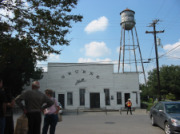
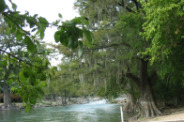
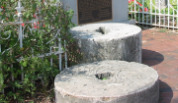

I happened on the Gruene historic district, now part of New Braunfels, Texas, while needing a driving break. It beckoned me with its intriguing old water tower. The flea market atmosphere and fun but unpretentious little shops were quite interesting.
This area, once an independent small town, could have well ended up deserted. But now it seemed very popular locally. The images are distinctive in my mind even today. I've long forgotten which little clay pot I purchased there. But I do remember that the pottery was local and made me want to buy something.
And I remembered the dance hall, because it seems so authentic to the place. I recall the large, efficient, and delicious restaurant because of its terrific outdoor ambiance where I could sit in very Texas-style furnishings eating Texas-style country food, and be close enough to real trees to touch them from my table. (Yes, good food is one of the secret community development principles. Where you have food, it should be good.)
This restaurant had one of the few great-looking signs seen anywhere in my travels.
Also it was great to go out and stick my toe right in the river, with the moss hanging off the trees overhead.
So for less than a three-hour visit, including lunch, I have five vivid memories that created a distinctive neighborhood character: a dance hall, an accessible river, a terrific restaurant that offered access to nature and didn’t pretend to be more or less than it is, a local potter, and a water tower that obviously was a local landmark.
And finally, I parked on grass, which I thought charming. Besides saving a huge amount of money by not paving the parking, think of how much better the water quality in their little stream is than it would have been had they paved enough parking to meet peak needs.
Like many an area, I'm now told that its historic preservation began with an architecture student and a new owner of a critical asset who embraced the concept. But over time, we guarantee that many others had to embrace sound community development principles to keep and enhance their character.
But the point is I've been in many towns in my life, and few made a larger impression of being "just right" in creating the linkage between tourism and economic development but also in maintaining the sense that yes, this place is real. It is not pretending to be something else. And it punched more than its weight in memorable small town character, even though it is now part of the city limits of a larger city.
Now let me tell you one more thing about my visit, and it's relevant to the community development principles about sense of place. I visited on a sunny October Sunday.
The flea market aspect of things may or may not have been a special event; I’m not sure. If I had visited on rainy Tuesday in March, when there were very few people around, I might have had a different impression.
But it might not have necessarily been a worse impression. The local shop owners would have had more time to talk with me, I might have felt more leisure to ask the waitress questions about the town, and I might have lingered longer taking photos of the dance hall instead of worrying about getting run over by a car.
Keep reading, because diversification is one of the most important community development principles.
Making one more mental switch before we draw a couple of conclusions, what if I had visited on Saturday night when the country music was in full swing? No doubt, the historic district would have been full, but with a more raucous mood in the air.
So what's important about the Gruene experience? The elements are broadly applicable as follows:
- The authentic
- The local
- The unpretentious (unless you have the pretentious schtick really working for you—see Las Vegas below)
- Critical mass of shops and things to do, at different times of day and night
- Landmarks (you can never get lost in Gruene because you can always look for the water tower)
- Good food
- The slightly unusual (for me, the country music dance hall, the apparent age of the water tower, the large quantity of grass parking, cactus by an old split rail fence where I parked, the lovely Spanish moss over the mostly clean little stream, the juxtaposition of an old white Victorian-style inn with a couple of grindstones from the old mill)
- Access to nature—and the option to ignore nature's most vicious extremes, depending on your preference and the weather
- The sense of safety because the environment, although richly detailed, was slightly predictable, and there was plenty of activity on the street. Following community development principles can bring the "eyes on the street" that help deter illegal activity and bad behavior, even in a small town.
- Cars are secondary to people, parking is on the periphery, the community is walkable and a bikeable community as a bonus, and traffic calming keeps cars in their place.
- There was just the right amount of signage to help me find my way.
Do you know what? I couldn't tell you a single negative about Gruene. As I try really hard to think of something that was a problem so I can comment, not a single negative detail comes to mind.
I could surmise, based on my previous experience with such locations, that the shops contained plenty of junk in lieu of antiques, that there were some really hoaky crafts, and that many of the shops were outright tourist traps and sold primarily little plaques with sentimental and ultimately meaningless sayings. But I could not tell you that for sure, because the positive memories based on sound community development principles are so strong.
Incidentally, if you are interested in the placemaking idea, you can scroll through our sitemap looking at the recently added photos and their captions.
2. Map your assets and wipe out your liabilities to achieve critical mass.
In this case let's look at down and out neighborhoods in an urban core. A traditional approach to neighborhood planning or community organizing would be problem-focused.
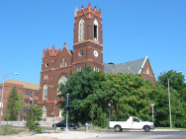
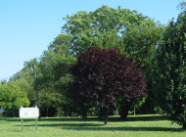
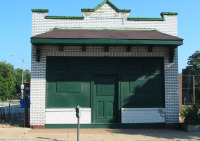
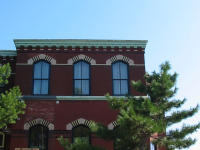
Following the tradition of the last fifty years, solutions would involve elaborate schemes for expenditure of public money to try to stimulate the private market to invest.
So I took a drive through what most Americans would judge to be a couple of highly undesirable neighborhoods. On this website we believe that the asset-based community development approach offers high value for all communities, but especially in declining neighborhoods. Here are some assets I found:
- A beautiful old stone church
- Gorgeous brick houses with stone and terra cotta ornamentation
- Empty lots where something new could be built
- An old empty gymnasium (unfortunately now falling down). See the abandoned buildings page.
- An unused neighborhood park sheltered from traffic
- Boarded-up classic American stand-alone commercial building structurally worth saving
- Two miles to a downtown of a major metropolitan area
- Availability of public transit
- Empty row of commercial buildings with display windows and in need of a concerted business attraction effort
The problem with a community with such a high volume of assets, but such a mediocre ratio of assets to liabilities, is that it needs to achieve critical mass.
Critical mass is everything when it comes to executing community development principles. In part of this example area, housing rehab movement occurred 20-30 years ago, but fizzled before the neighborhood turned around completely.
There simply weren't enough rehabbers to overcome the demographic wave of desperate low-income people who sought shelter in the remaining buildings. Many of the classy rehabs completed 30 years ago now are falling into disrepair again because big, old houses require plenty of maintenance.
Regardless of how many rehabs there were in days gone by, there weren't "enough."
Contrast this with another part of the area that has played it smarter and mounted a multi-pronged effort instead of relying mostly on a housing rehab trend.
The second sub-neighborhood might survive, through creating a community room, renovating a shopping street by chopping out the old mall that unwisely barred cars from passing through slowly, inviting live-work artists, learning how to fundraise so they could afford a real estate person on staff, and providing a farmer’s market serving as both an outlet for those who start a community garden and a means of providing rural-urban interaction.
After all, rural people coming to sell vegetables on Saturday morning are likely to take up a bit of the slack for the restaurant across the street, which lacks its downtown business customers for lunch on Saturdays.
It's all about critical mass and synergy between different uses--and tireless energy to try new things to see which ones work. After all, we can give you some general community development principles, but there are so many variables in community work that nothing works every time.
3. Diversify and expand laterally.
For this example, let's talk about Las Vegas. Not so long ago, Las Vegas was the place where people went to gamble and generally party. Motel rooms were very inexpensive, because of the need to bring people into the casinos. "Loss leader" buffets were the rule.
I'm leaving aside the fact that a gambling haven takes a real beating in a recession. What we're saying about its economic diversification is perhaps even more true when things get tough.
While vice appears to be readily available in Las Vegas still, there has been a lateral and logical expansion to add the best of art, food, shopping, shows, and other experiences for the senses.

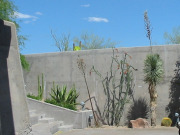
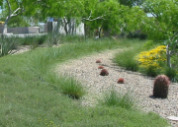
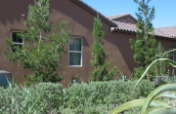
Each time I visit, the locals seem to understand more of the
notion that the desert climate and geology are to be celebrated and
respected, rather than camouflaged and denied.
By lateral expansion, we mean adding to and enhancing an already successful environment. Refusing to rest on your laurels is inherent in all these community development principles.
So what are the elements of lateral economic expansion that we see in Las Vegas?
- Business attraction, beginning with entrepreneurs who were willing to take a chance that serious art, great chefs, and high-end shopping wouldn't kill the gaming experience, but rather add to it.
- Embrace of nature through the outstanding Las Vegas Springs Preserve and the plan to focus attention on the Wash, a gulley to most of us but a river to Las Vegas, with an adjacent trail. And a casino dared to have windows!
- Development of a high-end residential component right on The Strip and of other residential opportunities nearby
- Willingness to stray beyond the tried and the true to reinvent the community into something even bigger and better through diversification
But people who aren't attracted to gaming, lights, noise, chain smoking, drinking, windowless and clock-free environments, staying indoors, and sex for sale now have a reason to add their numbers to the tourism as economic development picture.
While too much success proved to be a bad thing when people walked away from second homes lacking much equity, Las Vegas had a chance to survive its high foreclosure numbers and eventually stabilize neighborhoods because it built a solid economic base that adheres to the community development principles.
Taking it to the next level for Las Vegas may require going beyond tourism to attract a more educated population. That's why the increased embrace of nature, the desert environment, and xeriscape (landscaping with very low water requirements) are encouraging signs.
This community will need smart, educated residents, who would be interested in
abstract topics such as environmental sustainability, to deal even more
successfully with the impending water crisis. And if it replicates
the diversification of the tourist industry by improving its
educational and moral profile, great things will happen.
Join USEFUL COMMUNITY PLUS, which provides you monthly with short features or tips about timely topics for neighborhoods, towns and cities, community organizations, rural environments, and our international friends. Unsubscribe any time. Give it a try.
